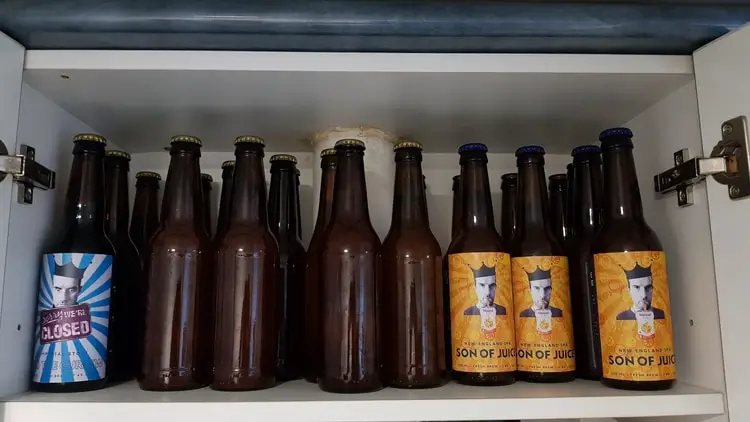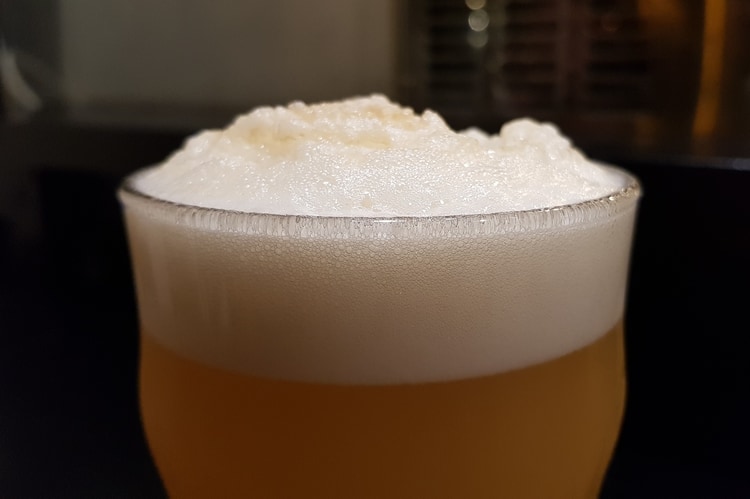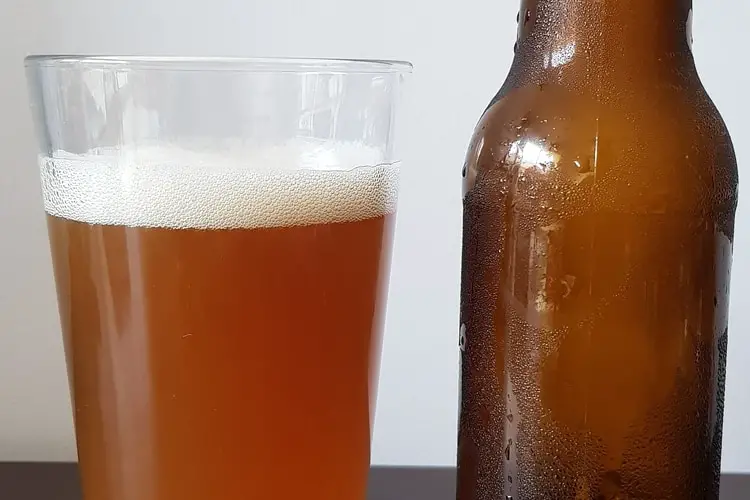Bubbles define beer and give it the kick that makes it so distinct. As a homebrewer, carbonating is routine. It needs to be done properly and with care.
I’ll discuss a different issue here: how long must one wait for good head? This question crosses our minds perpetually.
2 – 3 weeks is the standard time to carbonate bottled beer. If stored warmer a bit faster, and if in a basement or “cellar” a bit slower. It also depends on how long the beer conditioned or was racked. Longer pre-primed conditioning time can cause slower carbonation.
In truth, carbonation rates can vary from batch to batch. Unless one brews in a highly regulated temperature setting, beer and yeast will react differently batch to batch, yeast to yeast.
How Long to Carbonate Beer in Bottles?

As shown above, within three weeks the brewer is good to go.
My ideal beer spends a week in primary, racked for 2 weeks into secondary and then bottled.
My process lasts 5 -6 weeks for an ale.
Use ¾ cups of dextrose (corn sugar) by volume to prime your beer.
Stay away from sucrose though brown sugar may be OK.
This amount is suitable for 12 ounce and 22 ounce bottles.
Spring and fall are the best times to brew as the ambient temperature, assuming a mild climate, is 60 – 75˚ F (15 – 24° C).
Even if we need heat or AC at the beginning or end of a season, it will not be enough to affect the ambient temperature of the beer.
If concerned about the ambient temperature changing, even modestly, wrap the carboy in a blanket or jacket to keep it stable.
There are commercial options available to you.
Leaving the beer to age
A question often asked, “If I age my beer a long time, will it become over-carbonated?”
No: as long as it is not overprimed, it will not overcarbonate.
One issue that always causes problems is infection.
If wild yeast gets in the bottle it will continue to break down normally inaccessible sugars and starches and cause foaming or a burst bottle.
Unfortunately however, if you have an infection, bubbles are not the chief concern.
Priming stronger beers
Strong beers like Imperials, Barley Wines, Tripels… anything over 10 – 12% may behave a bit differently.
Firstly, they take more time to ferment.
They can spend 2 weeks in primary, 3 weeks in secondary, or much longer.
These beers require patience.
They convert a tremendous amount of sugar, require strong yeast, and often have complex malt profiles.
The yeast needs time to work and metabolize not just the sugar but reabsorb all the compounds produced during fermentation.
These include but are not limited to phenols, diacetyl, esters, fusel alcohol, and isoamyl acetate (the famed banana flavor).
Yeast dies off and sits.
In most cases, if racked properly it is not an issue.
If left on dead yeast cells too long, other dreaded flavors can form.
A couple of these dreaded flavors are Mercaptan (ethanethiol) and Hydrogen Sulphide (H2S).
They can lead to the kitchen sink drain, sulphury, and rotten egg flavors and aromas.
Don’t Panic! Have a Pan Galactic Gargle Blaster, sit a spell and listen to your favorite tunes.
This is an extreme case.
Tired yeast
The point of this is, yeast wears out, so if the beer is primed after 6 – 8 weeks and the beer is north of 11%, carbonation could take a very long time.
It may not ever truly form.
It may just leave a light lacing of bubbles around the glass and compliment the beer, not define it, nor be in balance with malt, yeast, and hop characteristics.
Belgian yeast will be least likely to give any problems and be resilient until the bitter (in this case malty) end, no matter the bottling date.
English or American yeast may get tired.
It could become stale after say 4 months.
This is not to say it will ruin the beer, it just does not age like Belgian strains.
If brewing with lager yeast and making an excessively strong Bock beer or one of the hybrid beers made in Switzerland for example, Samichlaus (14%); in the world’s strongest beers fermentation-based off-flavors aren’t the issue, but simply viability. Is the beer too strong for the yeast? Can the yeast then support bottle priming?
Repitching for bottling?
If concerned the yeast has worn out in the hi-octane brew, one technique to use is choose a high-quality dried yeast, hydrate it, and blend it with the beer in the bottling bucket.
Prime to the ordinary degree.
There is a limited amount of sugar in the bottle. Introducing the fresh yeast will guarantee viable cells to consume the sugar and give the desired amount of CO2 to the finished beer.
One final note about bottle repitching.
I’d once left beer to condition in fermenters for about 6 weeks. In retrospect, the only unique characteristic was that it was my first ½ – ½ beer, and it was blond, perhaps a Cream ale. It’s OG was 1.036 and the FG was 1.004!
I wanted it to be crystal clear.
I racked three times including bottling day.
It’s tertiary conditioning was about 1 month and there was virtually no yeast on bottling day.
The beer was clean and delicious though decidedly low in CO2.
If aging excessively long, for any style, you may need to add some yeast on packaging day.
How Long to Carbonate Beer in Kegs?
Carbonating beer in kegs is a different method. They have a much smaller outside surface area and head space relative to the volume compared to bottles.
In my experience, they need much less priming sugar.
When priming 5-gallon kegs use ½ cup (65 grams) or a bit less of dextrose.
When priming a half barrel keg (15.5 gal.) I used ¼ cup (32 grams) of dextrose per five gallons.
My experience extends here to maybe 12 kegs total, different styles, strengths, and ages.
Therefore, consider this an experimental section of the narrative. Read up, use references, and call on the experience in your home-brewery.
Do You Need to Keep Your Beers Cold After Carbonation?
I hadn’t a beer fridge dedicated to storage, so my homebrew stored at room temp, even in North Carolina mountain summers!
For the most part it was fine.
The only time that beer must be chilled after carbonation is if over-primed.
If over-primed is left at ambient temperatures there could be beer that bursts in your mouth like pop-rocks, gushes from the bottle, or bursts the bottle.
This leads to another key question…
Can I Over Carbonate My Homebrew?

Some prefer lots of bubbles. Brewing a golden ale, or light lager, we may be looking for that mass-produced lager effect.
We think to ourselves, “1 cup of corn sugar, hell, make it 1.5!”
Yes, I’ve done impetuous things.
It does not end well.
Stick to ¾ cup of sugar, mixed with young beer, 2 – 4 weeks old, and let it sit 1 – 2 weeks.
Works every time.
Does Homebrew Lose Carbonation Over Time?
Once primed and if the yeast has any life in it, gas will form and be trapped in the beer. There is nowhere for it to go until we open the bottle.
Some beers age well and are meant to age for months or years: the aforementioned strong beers as well as sour beers, like Lambics and Flemish Reds.
Especially in the sour beers, they will continue to off-gas over time, as wild yeast metabolizes on a deeper level than pure strains.
In the end, the gas stays in the bottle.
Last Thought Bubbles
Our carbonation chiefly considers priming sugar and what to expect after bottling or kegging. If homebrew kegging, there are CO2 injection methods open to you.
Most of my kegging was done commercially when the beer was already 32˚ F and carbonated.
99% of commercial packaging, kegs, bottles, and cans occurs when the beer is already carbonated. Commercial priming is rare, though some breweries will bottle condition on the yeast.
Remember to keep the yeast viable, don’t wait too long. Belgian yeasts are more forgiving. Strong ales can wear a yeast out.
Many things to consider. If it were easy, everyone would do it. Enjoy!

